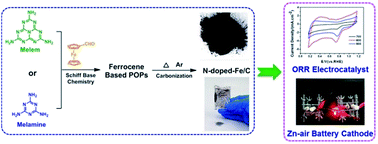Ferrocene-based porous organic polymer derived high-performance electrocatalysts for oxygen reduction†
Abstract
Two nitrogen-rich porous organic polymers (POPs) were prepared via facile and low-cost Schiff base chemistry with ferrocene (Fc) and melamine/melem as building blocks. Carbonization of these POP precursors results in porous carbon nanohybrids with carbon composites containing crystalline Fe3C/Fe. Characterization based on a variety of techniques demonstrates that the porous carbon nanohybrids feature rich-nitrogen doping, good conductivity and high BET surface area with unique porous structure, endowing them with an excellent catalytic activity toward the oxygen reduction reaction (ORR) in alkaline electrolytes. The catalysts obtained by carbonization at 800 °C (N-Fc-800) exhibit favorable activity with a rather high onset potential and half wave potential of 0.96 and 0.82 V, respectively. Furthermore, a rechargeable zinc-air battery was assembled using the N-Fc-800 as the cathode catalyst. Compared with the commercial Pt/C, the N-Fc-800 based battery displays a considerably high power density of 178 mW cm−2 with a smaller charge–discharge voltage gap of 0.94 V, and holds excellent stability with a less activity decay (1.0%) over long charge–discharge cycles (200 cycles).



 Please wait while we load your content...
Please wait while we load your content...